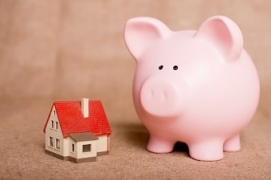Archived article
Please note that tax, investment, pension and ISA rules can change and the information and any views contained in this article may now be inaccurate.

On the retirement income battlefield, one war has waged more fiercely than any other – pensions versus property. Property evangelists insist you’d be better off sticking your savings in bricks and mortar, while pensions nerds steadfastly back the tax-advantaged retirement vehicle.
But who is right? And what should you consider when deciding whether to put your hard-earned cash in property or pensions?
The maths
As is often the case when investing for retirement, the answer is by no means black and white. Bearing that in mind, myself and the technical whizzes at AJ Bell looked at how well you would do if you invested in a pension against buy-to-let.
Before we get to the results, the inevitable caveats (sorry, please bear with me). This analysis is based on past investment performance and house price growth, which may not provide a guide to the future. We’ve also had to estimate things like charges for your pension and rental income for buy-to-let, which again are only educated guesses.
The results are therefore indicative rather than absolute. They are, nonetheless, fascinating, and as you can see from Figure 1, it’s a close run thing.
Someone investing £100,000 in a pension would, in our model, see their pot grow to over £200,000 in the ten years before retirement. A single buy-to-let property, on the other hand, returns just £123,095 over the same period, with annual rental income of £4,118 on top. Roll up that income over a decade and the pension is still, comfortably, the winner. See assumptions below
However, if our investor sticks their money into three buy-to-let properties – putting down deposits on each and borrowing from the bank at rock bottom interest rates – they would be significantly better off both pre and post-retirement.
Reality check
Many people like the idea of investing in property because it is tangible and feels easier to understand. However, our analysis shows that simply buying one buy-to-let property instead of a pension is unlikely to deliver a better outcome.
Unless you are prepared to take on multiple buy-to-let properties and borrow significant amounts of money to do so, a pension is likely to be the easiest and most profitable way to save for your retirement. Borrowing also adds extra risk – your returns are multiplied, but so are your losses if the market takes a nosedive. In addition, with you are also putting all your eggs in one basket, whereas your pension can be diversified across assets and countries to reduce your exposure to market shocks.
You can start saving in a pension from as little as £1 per month via a direct debit. For property you need to have a deposit, probably of around £20,000 to £30,000, but most people can’t afford a deposit on their own home let alone a second property for investment purposes.
The Government will also make contributions to your pension via generous tax breaks and if you are employed, the company you work for now generally has to provide a pension for you and contribute to it too.
In reality, investing in buy-to-let property is no substitute for saving through a pension. Really the debate should not be around whether property is an alternative to a pension, but whether property would make a good addition to your overall retirement income strategy once a retirement income foundation has been established.
| Value of investment after 10 years (pre-retirement) | Annual income over period (pre-tax, pre-retirement) | Annual income (pre-tax, post-retirement) | Value of investment in another 10 yrs (post-retirement) | |
| Buy-to-let (1 property) | £123,095 | £4,118 | £4,549 | £156,331 |
| Buy-to let (3 properties) | £171,600 | £7,242 | £7,844 | £217,932 |
| Pension (drawdown) | £203,612 | £0 | £8,000 | £174,088 |
Figure 1. Source: AJ Bell
Assumptions:
Buy-to-let
House price growth matches that achieved over the past 10 years. Average UK house price in July 2006 was £170,604. In July 2016 it was £216,750 – growth of 27% - http://landregistry.data.gov.uk/app/ukhpi/explore
Gross rental yield of 6%
Pension
Annual investment growth via the pension of 5% post charges (FTSE All Share has returned 5.8% over past 10 years)
Pension withdrawal rate of £8,000 is approximately 4% per annum - aligned with a standard annuity rate
Annual investment growth in drawdown of 3% per annum post charges to reflect lower risk
Related content
- Thu, 06/04/2023 - 09:51
- Mon, 13/03/2023 - 12:44
- Thu, 02/03/2023 - 12:43
- Wed, 01/02/2023 - 14:06
- Wed, 04/01/2023 - 15:36

